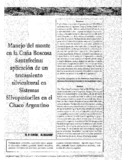Mostrar el registro sencillo del ítem
Manejo del monte en la Cuña Boscosa Santafecina: aplicación de un tratamiento silvicultural en sistemas silvopastoriles en el chaco argentino
| dc.contributor.author | Simon, M.P. | |
| dc.contributor.author | Ibrahim, Muhammad Akbar | es_ES |
| dc.date.accessioned | 2015-03-19T21:52:00Z | |
| dc.date.available | 2015-03-19T21:52:00Z | |
| dc.date.issued | 1997 | |
| dc.identifier | 472550 | es_ES |
| dc.identifier.issn | 1022-7482 | es_ES |
| dc.identifier.uri | https://repositorio.catie.ac.cr/handle/11554/6547 | |
| dc.identifier.uri | http://orton.catie.ac.cr/repdoc/A2662e/A2662e.pdf | es_ES |
| dc.description | 6 ilus. 1 tab. 8 ref. 6 pág. | es_ES |
| dc.description.abstract | La presencia de especies forestales nativas de valor comercial en todo el dominio chaqueño, hace de los sistemas silvopastoriles una forma sostenible de producir. Mediante la silvicultura (desarbustado, podas, raleo y extracción de árboles enfermos) y la protección de especies maderables (manejo de carga animal, período de descanso de pastos adecuados) aplicados a dos tipos de vegetación: monte fuerte y un bosque secundario de quebracho, se logró aumentar la producción del pastizal. En ambos tipos de vegetación la producción de forrajes se duplicó, especialmente en la época lluviosa. En el manejo de la regeneración se observó que, manejando la carga animal y con disponibilidad de forraje, es posible disminuir e incluso eliminar los daños que el ganado vacuno causa a la regeración arbórea. Se concluye que ambos tratamientos mejoran la producción del pastizal. The presence of native tree species of commercial blue throughout the Chaco creates silvopastoral systems which offer sustainable production. Through silviculture (clearing bush, pruning, thinning and removing diseased trees) and the protection of timber species (control o grazing intensity, adequate rest periods of pastures) applied to two types of vegetation (thick scrub and young aspidosperma secondary forests), it was possible to increase pasture production. In both types of vegetation, forage production was double, especially in the rainy seaseon. In the management of the regrowth, it was observed that the damage caused by cattle to regenerating trees could be diminished and even eliminated by controlling the grazing intensity and offering sufficient forage. It was concluded that both treatments improved pasture production. | es_ES |
| dc.language.iso | es | es_ES |
| dc.publisher | CATIE, Turrialba (Costa Rica) | es_ES |
| dc.relation.ispartof | Agroforestería en las Américas v.4 n.15 p.14-19 | |
| dc.subject | MANEJO FORESTAL | es_ES |
| dc.subject | REGENERACION NATURAL | es_ES |
| dc.subject | RUPRECHTIA LAXIFLORA | es_ES |
| dc.subject | BUMELIA OBTUSIFOLIA | es_ES |
| dc.subject | CAESALPINIA PARAGUARIENSIS | es_ES |
| dc.subject | SCHINOPSIS BALANSAE | es_ES |
| dc.subject | PROSOPIS ALBA | es_ES |
| dc.subject | ASPIDOSPERMA QUEBRACHO | es_ES |
| dc.subject | TRATAMIENTOS SILVICULTURALES | es_ES |
| dc.subject | ARGENTINA | es_ES |
| dc.title | Manejo del monte en la Cuña Boscosa Santafecina: aplicación de un tratamiento silvicultural en sistemas silvopastoriles en el chaco argentino | es_ES |
| dc.title.alternative | Vegetation management in the Santafecina forest basin: application of silvicultural treatment in the Argentinian Chaco | es_ES |
| dc.type | Artículo | es_ES |
| dc.journal.issueNumber | 15 |


